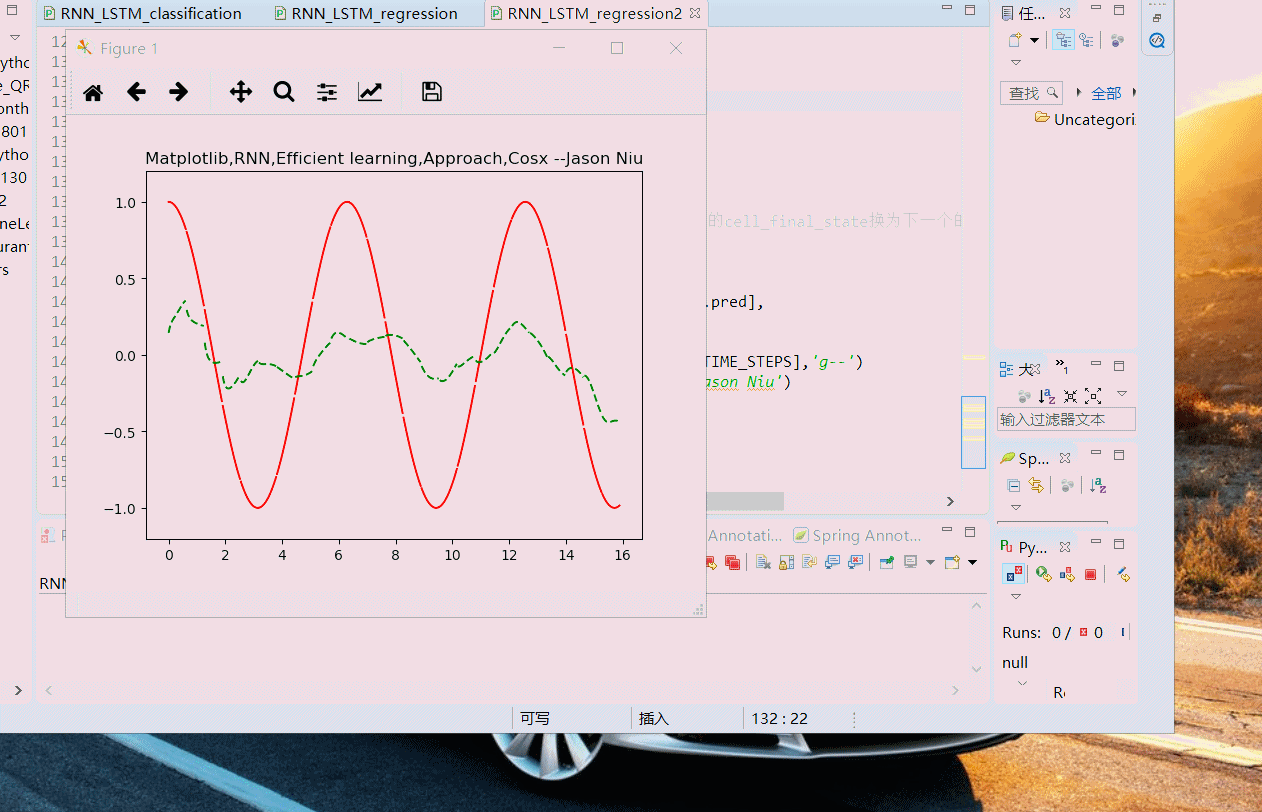TF之RNN:matplotlib动态演示之基于顺序的RNN回归案例实现高效学习逐步逼近余弦曲线—Jason niu
import tensorflow as tf
import numpy as np
import matplotlib.pyplot as plt BATCH_START = 0
TIME_STEPS = 20
BATCH_SIZE = 50
INPUT_SIZE = 1
OUTPUT_SIZE = 1
CELL_SIZE = 10
LR = 0.006
BATCH_START_TEST = 0 def get_batch():
global BATCH_START, TIME_STEPS
# xs shape (50batch, 20steps)
xs = np.arange(BATCH_START, BATCH_START+TIME_STEPS*BATCH_SIZE).reshape((BATCH_SIZE, TIME_STEPS)) / (10*np.pi)
seq = np.sin(xs)
res = np.cos(xs)
BATCH_START += TIME_STEPS
return [seq[:, :, np.newaxis], res[:, :, np.newaxis], xs] class LSTMRNN(object):
def __init__(self, n_steps, input_size, output_size, cell_size, batch_size):
self.n_steps = n_steps
self.input_size = input_size
self.output_size = output_size
self.cell_size = cell_size
self.batch_size = batch_size
with tf.name_scope('inputs'):
self.xs = tf.placeholder(tf.float32, [None, n_steps, input_size], name='xs')
self.ys = tf.placeholder(tf.float32, [None, n_steps, output_size], name='ys')
with tf.variable_scope('in_hidden'):
self.add_input_layer()
with tf.variable_scope('LSTM_cell'):
self.add_cell()
with tf.variable_scope('out_hidden'):
self.add_output_layer()
with tf.name_scope('cost'):
self.compute_cost()
with tf.name_scope('train'):
self.train_op = tf.train.AdamOptimizer(LR).minimize(self.cost) def add_input_layer(self,):
l_in_x = tf.reshape(self.xs, [-1, self.input_size], name='2_2D')
Ws_in = self._weight_variable([self.input_size, self.cell_size])
bs_in = self._bias_variable([self.cell_size,])
with tf.name_scope('Wx_plus_b'):
l_in_y = tf.matmul(l_in_x, Ws_in) + bs_in
self.l_in_y = tf.reshape(l_in_y, [-1, self.n_steps, self.cell_size], name='2_3D') def add_cell(self):
lstm_cell = tf.nn.rnn_cell.BasicLSTMCell(self.cell_size, forget_bias=1.0, state_is_tuple=True)
with tf.name_scope('initial_state'):
self.cell_init_state = lstm_cell.zero_state(self.batch_size, dtype=tf.float32)
self.cell_outputs, self.cell_final_state = tf.nn.dynamic_rnn(
lstm_cell, self.l_in_y, initial_state=self.cell_init_state, time_major=False) def add_output_layer(self):
l_out_x = tf.reshape(self.cell_outputs, [-1, self.cell_size], name='2_2D')
Ws_out = self._weight_variable([self.cell_size, self.output_size])
bs_out = self._bias_variable([self.output_size, ])
with tf.name_scope('Wx_plus_b'):
self.pred = tf.matmul(l_out_x, Ws_out) + bs_out def compute_cost(self):
losses = tf.contrib.legacy_seq2seq.sequence_loss_by_example(
[tf.reshape(self.pred, [-1], name='reshape_pred')],
[tf.reshape(self.ys, [-1], name='reshape_target')],
[tf.ones([self.batch_size * self.n_steps], dtype=tf.float32)],
average_across_timesteps=True,
softmax_loss_function=self.ms_error,
name='losses'
)
with tf.name_scope('average_cost'):
self.cost = tf.div(
tf.reduce_sum(losses, name='losses_sum'),
self.batch_size,
name='average_cost')
tf.summary.scalar('cost', self.cost) def ms_error(self, y_target, y_pre):
return tf.square(tf.sub(y_target, y_pre)) def _weight_variable(self, shape, name='weights'):
initializer = tf.random_normal_initializer(mean=0., stddev=1.,)
return tf.get_variable(shape=shape, initializer=initializer, name=name) def _bias_variable(self, shape, name='biases'):
initializer = tf.constant_initializer(0.1)
return tf.get_variable(name=name, shape=shape, initializer=initializer) if __name__ == '__main__':
model = LSTMRNN(TIME_STEPS, INPUT_SIZE, OUTPUT_SIZE, CELL_SIZE, BATCH_SIZE)
sess = tf.Session()
merged=tf.summary.merge_all()
writer=tf.summary.FileWriter("niu0127/logs0127",sess.graph)
sess.run(tf.initialize_all_variables()) plt.ion()
plt.show() for i in range(200):
seq, res, xs = get_batch()
if i == 0:
feed_dict = {
model.xs: seq,
model.ys: res,
}
else:
feed_dict = {
model.xs: seq,
model.ys: res,
model.cell_init_state: state
}
_, cost, state, pred = sess.run(
[model.train_op, model.cost, model.cell_final_state, model.pred],
feed_dict=feed_dict) plt.plot(xs[0,:],res[0].flatten(),'r',xs[0,:],pred.flatten()[:TIME_STEPS],'g--')
plt.title('Matplotlib,RNN,Efficient learning,Approach,Cosx --Jason Niu')
plt.ylim((-1.2,1.2))
plt.draw()
plt.pause(0.1)

TF之RNN:matplotlib动态演示之基于顺序的RNN回归案例实现高效学习逐步逼近余弦曲线—Jason niu的更多相关文章
- TF之RNN:TensorBoard可视化之基于顺序的RNN回归案例实现蓝色正弦虚线预测红色余弦实线—Jason niu
import tensorflow as tf import numpy as np import matplotlib.pyplot as plt BATCH_START = 0 TIME_STEP ...
- TF之NN:matplotlib动态演示深度学习之tensorflow将神经网络系统自动学习并优化修正并且将输出结果可视化—Jason niu
import tensorflow as tf import numpy as np import matplotlib.pyplot as plt def add_layer(inputs, in_ ...
- TF之RNN:基于顺序的RNN分类案例对手写数字图片mnist数据集实现高精度预测—Jason niu
import tensorflow as tf from tensorflow.examples.tutorials.mnist import input_data mnist = input_dat ...
- TF:利用TF的train.Saver载入曾经训练好的variables(W、b)以供预测新的数据—Jason niu
import tensorflow as tf import numpy as np W = tf.Variable(np.arange(6).reshape((2, 3)), dtype=tf.fl ...
- TensorFlow RNN MNIST字符识别演示快速了解TF RNN核心框架
TensorFlow RNN MNIST字符识别演示快速了解TF RNN核心框架 http://blog.sina.com.cn/s/blog_4b0020f30102wv4l.html
- [Unity][Heap sort]用Unity动态演示堆排序的过程(How Heap Sort Works)
[Unity][Heap sort]用Unity动态演示堆排序的过程 How Heap Sort Works 最近做了一个用Unity3D动态演示堆排序过程的程序. I've made this ap ...
- 关于csdn博客中案例效果的动态演示
在曾经一篇博文中,网友评论说要是案例效果是动态演示的就好了,我认为说的非常是有道理.由于一个简单的截图不能非常好的展示案例效果.要是有一张gif图能动态的播放案例效果就再好只是了.在这里提供一个小软件 ...
- 【Java】代理模式,静态代理和动态代理(基于JDK或CGLib)
当我们需要在一个方法之前或之后添加一段逻辑时,自然会想到使用代理类.代理类帮我们代理了实际类的调用,然后可以在实际调用之前和之后添加一些逻辑,从而不浸入实际类. 拓展:由于代理类能在实际类调用之前和之 ...
- Java 动态代理是基于什么原理
动态代理 ①动态代理概念理解 动态代理是一种方便运行时动态构建代理.动态处理代理方法调用的机制,很多场景都利用类似机制做到的,比如用来包装RPC调用.面向切面的变成(AOP) 实现动态代理的方式很多, ...
随机推荐
- Confluence 6 附件是如何被索引的
当一个文件被上传到 Confluence 后,Confluence 将会尝试对文件进行解压,然后对文件中的内容进行索引.这样系统就能够允许用户对文件中的内容进行搜索,而不仅仅是搜索文件名.这个过程对系 ...
- ios蓝牙详解
最近这段时间在研究蓝牙,也研究了一段时间了现在在下面做个总结 1 其实蓝牙连接只要明白了整体原理,其实挺简单的 2 大部分情况下,手机作为中心管理者,而连接的设备被称为外设,外设的结构有点像一颗大树 ...
- NHibernate入门
这里是官方的Demo,可以看看,因为我也是通过官方的demo学习的. https://github.com/nhibernate/nhibernate-core/tree/master/src/N ...
- STL的注意事项
template是一个泛化的:使用template时开始仅仅是声明,具体的例如:k<int> a;叫做实例化显式实例化:类似k<int>a:明确指出哪种类型:隐式实例化:类似k ...
- LeetCode(73):矩阵置零
Medium! 题目描述: 给定一个 m x n 的矩阵,如果一个元素为 0,则将其所在行和列的所有元素都设为 0.请使用原地算法. 示例 1: 输入: [ [1,1,1], [1,0,1], ...
- jQuery绑定或删除绑定事件
<!DOCTYPE html><html lang="en" class="loading"><head> <meta ...
- sass编写高质量的css---(基础语法结构)
一:基础1.Sass:最早也是最成熟的CSS预处理语言2.Less:兼容CSS的最流行的css预处理语言3.Stylus:主要用于node.js社区 二:scss写法1)混入@mixin alert( ...
- JAVA,字符串替换
package l515; //例5.15 //字符串替换 public class NewStr { public static void main(String[] args) { String ...
- Redis监控和告警
https://blog.csdn.net/isoleo/article/details/52981140
- [转] JavaScript设计模式之发布-订阅模式(观察者模式)-Part1
<JavaScript设计模式与开发实践>读书笔记. 发布-订阅模式又叫观察者模式,它定义了对象之间的一种一对多的依赖关系.当一个对象的状态发生改变时,所有依赖它的对象都将得到通知. 例如 ...
